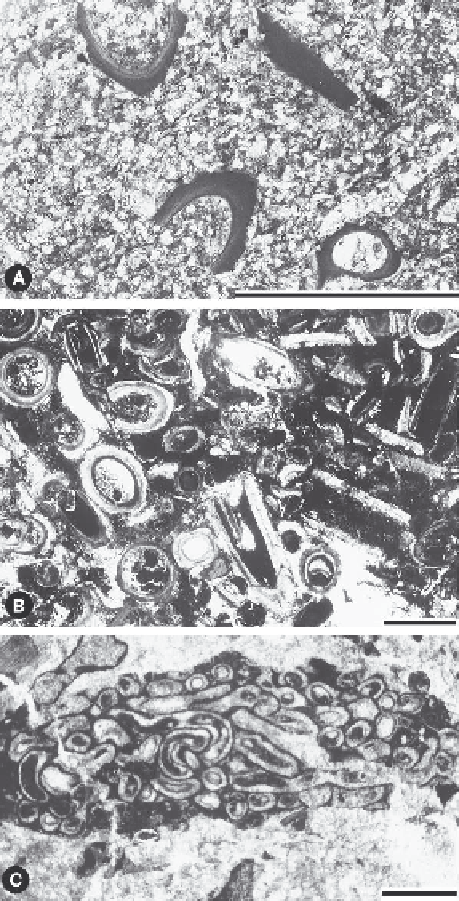Geology Reference
In-Depth Information
well as serpulid 'colonies' which attribute in the con-
struction of 'reef' structures. Many serpulids are char-
acterized by a microstructure consisting of two layers
which in longitudinal sections show an outer cone-in-
cone pattern and a clear or laminated inner layer (Pl.
92/6, 7). In tangential sections the shell layers appear
as concentric rings (Pl. 92/8). Spirorbid calcareous
worms are fixed with supporting structures on hard or
soft substrates (Pl. 92/5).
Paleoenvironmental significance:
Serpulids occur in
very different environments (including shallow and
rocky coasts, sea grass areas, hard and firm sea bot-
toms, deep-marine habitats). They can live in warm and
temperate seas, and are adapted to various salinities.
The fossil record comprises scattered bioclasts, rock-
building accumulations of serpulid tubes or autochtho-
nous reef-like structures (Fig. 10.48).
Modern serpulid '
reefs'
are represented by banks de-
posited in instable marine habitats (commonly near-
coastal environments; often mixo- or hypersaline) on
shallow parts of continental shelves, and by meter-sized
framework reefs at intertidal and subtidal depths, down
to 30 m depths, mainly in sheltered coastal lagoonal
conditions (Ten Hove and Van Den Hurk 1993; Fornos
et al. 1997). Buildups dominated by masses of serpulid
tubes associated with coralline red algae are known
from lagoonal environments of the Bermudas (Pl. 92/
1), but also occur in cold-water environments of Ant-
arctica.
Ancient serpulid reefs are known from the Early
Carboniferous of England (Wright and Wright 1981),
from the Early Cretaceous of Argentina (Palma 1992)
and of central Europe (Berriasian: hypersaline 'Serpulit'
beds) as well as from Miocene lagoonal or brackish-
water environments (Pl. 92/3). Associations of serpulids
and microbial carbonates are common. Examples are
Late Triassic serpulid/microbial reefs consisting of ser-
pulid aggregates, microbial crusts and abundant syn-
sedimentary carbonate cements (Flügel 2002). In the
Late Tertiary, serpulids in association with microbes
formed small-scaled reefs in near-coastal environments
(Jasionowski and Wysocka 1997).
Fig. 10.48.
Allochthonous and autochthonous serpulid
records.
A
: Scattered and broken serpulid tubes redeposited
in quartz sand. Early Cretaceous: Subsurface, Endelhausen
1, southern Bavaria.
B
: Rock-building concentration of ser-
pulid tubes. Middle Jurassic: Würgau, Northern Franconian
Alb, Germany.
C
: Serpulid 'colony' contributing to the for-
mation of centimeter- to meter-sized reefs in near-coast, of-
ten brackish settings. Late Tertiary (Miocene): Poland. Scale
is 2 mm.
Agglutinated worm tubes are constructed by silici-
clastic sand and silt grains, carbonate and organic ma-
terial (Pl. 92/9, 10). These tubes have been known since
the Early Carboniferous, often associated with reef en-
vironments. Different names are in use for designating
annelid agglutinated mucous sheats tending to early ce-
mentation and reworking from the enclosing sediment
(
Terebella, Thartharella, Prethocoprolithus;
see Delvolvé
et al. 1994).
Basics: Serpulid worms
Brönnimann, P., Zaninetti, L. (1972): On the occurrence of
the serpulid
Spirorbis
Daudin, 1800 (Annelida, Poly-
chaeta, Sedentaria) in thin sections of Triassic rocks of
Europe and Iran. - Rivista Italiana di Paleontologia e
Stratigrafia,
78
, 67-90
Götz, G. (1931): Bau und Biologie fossiler Serpuliden. -
Neues Jahrbuch für Mineralogie, Geologie und Paläonto-
logie, B,
66
, 385-438

